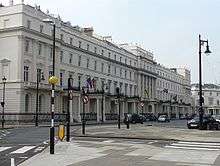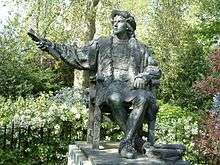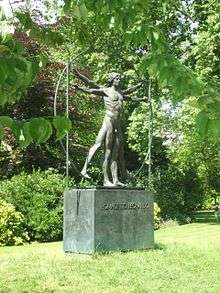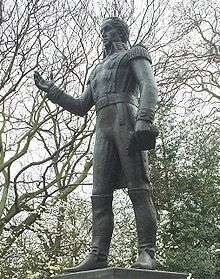Belgrave Square


Belgrave Square is one of the grandest and largest 19th-century squares in London, England. It is the centrepiece of Belgravia, and was laid out by the property contractor Thomas Cubitt for the 2nd Earl Grosvenor, later the 1st Marquess of Westminster, in the 1820s. Most of the houses were occupied by 1840. The square takes its name from one of the Duke of Westminster's subsidiary titles, Viscount Belgrave. The village of Belgrave, Cheshire is two miles (3 km) from the Grosvenor family's main country seat of Eaton Hall. Today, many embassies are based in the square.
History
The original scheme consisted of four terraces, each made up of eleven grand white stuccoed houses, apart from the south east terrace, which has twelve; detached mansions in three of the corners; and a private central garden. The numbering is anticlockwise from the north: NW terrace Nos. 1 to 11; west corner mansion No. 12; SW terrace 13–23; south corner mansion No. 24; SE terrace Nos. 25–36; east corner mansion No. 37; NE terrace Nos. 38–48. There is also slightly later detached house at the northern corner, No. 49, which was built in by Cubitt for Sidney Herbert in 1851. The terraces were designed by George Basevi and are possibly the grandest houses ever built in London on a speculative basis. The largest of the corner mansions, Seaford House in the east corner, was designed by Philip Hardwick, and the one in the west corner was designed by Robert Smirke. The square features statues of Christopher Columbus, Simón Bolívar, José de San Martín, Prince Henry the Navigator, and the 1st Marquess of Westminster, a bust of George Basevi, and a sculpture entitled Homage to Leonardo by Italian sculptor Enzo Plazzotta.[1]
From its construction until World War II, the square was occupied by leading members of the British aristocracy, with an increasing number of plutocrats added to the mix in later decades. Its immediate success was encapsulated by the decision of another of London's leading freehold landlords, the Duke of Bedford, to choose No. 6 as his London home in preference to a house on his own London estate in Bloomsbury, which had lost its aristocratic cachet.[2]
During World War II, it was used as a tank park. The square has been a favoured location for embassies since the nineteenth century, and houses several to this day, including the German Embassy, which occupies three houses on the west side. After World War II, most of the houses were converted into offices for charities and institutes. This is now being reversed, with leases of three houses being offered for sale and conversion to residential use by the Grosvenor Estate in 2004. The present Duke of Westminster remains the freeholder of the square.
Many of the buildings on the square are listed; the Spanish Embassy at 24 Belgrave Square,[3] 1–11,[4] 12,[5] 13–23,[6] 25–36,[7] 38–48,[8] are all listed Grade I. 49 Belgrave Square and Seaford House at 37 Belgrave Square are listed II*,[9][10] and 11a is listed Grade II.[11] In addition to the buildings, the railings and gate piers of 12, 24, and 49 are listed II*.[12][13][14]
Individual properties
1 Belgrave Square was the official residence of the Ambassadors of Romania from 1936 to 2005. Since 2006, the building continues to host events for the Embassy and is also headquarters of the Romanian Cultural Institute in London.[15]
2 Belgrave Square was first leased (c. 1829) to a wealthy brewer, James Goding. Later residents included James Hamilton, 2nd Duke of Abercorn, Edward Balfour and Nathaniel Clayton. In the 20th century, 2 Belgrave Square was purchased by the British soldier and politician, Ernest George Pretyman and his wife, Lady Beatrice, daughter of George Bridgeman, 4th Earl of Bradford. In 1935, after Pretyman’s death, the house was sold to Grace, Lady Dance. On 12 May 1953, it was re-opened by the Duke of Gloucester as the base of the Hispanic and Luso-Brazilian Council.
3 Belgrave Square was the London home of the Duke of Kent and birthplace, in 1935, of the current Duke [16] and of Princess Alexandra the following year.
4 Belgrave Square was the home of Admiral of the Fleet Sir Charles Ogle.[17]
5 Belgrave Square was the home of Sir George Murray Secretary for War and the Colonies until he died there in 1846, Chips Channon from 1935 to 1958, and later housed the Institute of Directors, followed by the British Plastics Federation.[18]
10 Belgrave Square was the London home of William Cavendish, 7th Duke of Devonshire.[19]
13 Belgrave Square was used by the St John Ambulance Brigade as a base in World War I.
16 Belgrave Square was the home for many years of Sir Roderick Impey Murchison, the geographer and geologist, and his wife, geologist Charlotte Murchison, and later of Charles Henry Crompton-Roberts.
17 Belgrave Square, was the base of the Royal College of Psychiatrists until the College relocated in October 2013, and was home to two MPs, Sir Ralph Howard and Pandeli Ralli. Leontine, Lady Sassoon was in residence 1929–52. She is said to have held parties for soldiers during the Second World War, while part of the property was used as a Red Cross supply depot. No 17 was taken over by the Institute of Metals in 1956 and the College came in 1974.[20]
18 Belgrave Square has been the home of the Austrian Embassy since 1866. It is the only building of those used by the Austro-Hungarian Empire's Foreign Service still used today by the Republic of Austria diplomacy.[21]
During 1846-1851 number 18 was inhabited by Sir Francis Egerton (born Leveson-Gower), the 1st Earl of Ellesmere, and his family. Due to the rebuilding of Cleveland House (St. James's), which would be renamed Bridgewater House, the Earl of Ellesmere was also forced to house his famed "Bridgewater Collection of Pictures" at nr. 18, using bedrooms, dinnerrooms, hallways etc. For a description see Art-Union vol ix (1847), p. 8-12, 49-52. During this period the public collection was closed to the public. It was re-opened when the Collection had been moved back to Bridgewater House in 1851.
21–23 Belgrave Square has been the Embassy of the Federal Republic of Germany since 1955. The buildings were leased for 99 years in 1953 and converted into a combined property.[22]
24 Belgrave Square is in the south corner of Belgrave Square; in the early part of the 20th Century it was known as Downshire House, the London home of Lord and Lady William James Pirrie. Lord Pirrie was the chairman of Harland and Wolff, a leading shipbuilding firm located in Belfast, Northern Ireland. One evening in July 1907, the Pirries hosted J. Bruce and Florence Ismay for dinner. J. Bruce Ismay was the managing director of the White Star Line, one of the top shipping companies of the North Atlantic. Harland and Wolff constructed all of White Star's vessels. White Star's main rival was the Cunard Line. The Cunard Line's newest ships, the Mauretania and Lusitania, the largest ships in the world, had just entered service. Pirrie and Ismay discussed the new ships during the dinner, and how to counter the competition of these new ships. Their discussions led to them planning that night the construction of three ships, larger than any in the world. The names of the ships would be RMS Olympic, RMS Titanic and RMS Britannic. It is now the Embassy of Spain.
28 Belgrave Square was the home of Robert Carew, 3rd Baron Carew, who died there on 29 April 1923.It is now home of Embassy of Republic of Serbia.
29 Belgrave Square Sir Winston Churchill received his fist cabinet appointment in this building in 1906 from the Prime Minister of the time Sir Henry Campbell Bannerman
34 Belgrave Square was the embassy of the German Democratic Republic until reunification in 1990.
36 Belgrave Square, known as Ingestre House, was leased by Queen Victoria as a home for her mother, the widowed Duchess of Kent.
37 Belgrave Square, known as Seaford House was built in 1842 by Philip Hardwick for the Earl of Sefton. In 1902, Sefton House was remodeled for Lord Howard de Walden, (Baron Seaford). It is now the home of Royal College of Defence Studies.
49 Belgrave Square, Herbert House, was the home of Sidney Herbert, 1st Baron Herbert of Lea, and then Charles Gordon-Lennox, 6th Duke of Richmond.
Gardens
The communal garden is 2 hectares (4.9 acres) in size and contains mature plane, chesnut, and lime trees, and various shrubs. A tennis court and wooden pergolas and shelters stand in the garden. The garden is listed Grade II listed on the Register of Historic Parks and Gardens. The gravel walks in the garden were laid in 1854 with privet hedges planted around its perimeter.[23] It is not open to the public.[24]
21st century tenants
The Square is now a centre for embassies and institutions.
- Romanian Cultural Institute section of the Embassy of Romania, 1 Belgrave Square
- Canning House – The Hispanic & Luso Brazilian Council, 2 Belgrave Square
- Oleg Deripaska – 5 Belgrave Square[25]
- The Embassy of Syria, 8 Belgrave Square
- The Official Residence of the Ambassador of Kuwait, 11A Belgrave Square
- The Embassy of Portugal, 11–12 Belgrave Square
- The High Commission of Ghana, 13 Belgrave Square
- The Society of Chemical Industry, 14–15 Belgrave Square
- The Country Land and Business Association, 16 Belgrave Square
- The Official Residence of the Austrian Ambassador, 18 Belgrave Square
- The Bruneian High Commission, 19–20 Belgrave Square
- The Embassy of Germany, (21)–23 Belgrave Square
- The Embassy of Spain, 24 Belgrave Square
- The Royal Norwegian Embassy, 25 Belgrave Square
- The Embassy of Serbia, 28 Belgrave Square
- The Embassy of Bahrain, 30 Belgrave Square [26]
- Henadiy Boholyubov of Privat Group, 31 Belgrave Square
- The Royal College of Defence Studies, Seaford House, 37 Belgrave Square
- The Caledonian Club, corner of Belgrave Square & Halkin Street
- Italian Cultural Institute, 39 Belgrave Square
- The Trinidad & Tobago High Commission, 42 Belgrave Square
- The Turkish Embassy, 43 Belgrave Square
- The Institute of Practitioners in Advertising, 44 Belgrave Square
- The Malaysian High Commission, 45 Belgrave Square
- Meridian Group, 47 Belgrave Square
- The Official Residence of the Mexican Ambassador, 48 Belgrave Square
- Argentine Ambassador's Residence, 49 Belgrave Square
References
- ↑ Bob Speel. "Belgrave Square". Archived from the original on 8 August 2008. Retrieved 2009-12-03.
- ↑ Page 75, London in the 19th Century, Jerry White (2007). ISBN 978-0-7126-0030-9
- ↑ Historic England, "Spanish Embassy (1218320)", National Heritage List for England, retrieved 15 February 2016
- ↑ Historic England, "1–11 Belgrave Square (1066455)", National Heritage List for England, retrieved 15 February 2016
- ↑ Historic England, "12 Belgrave Square (1066456)", National Heritage List for England, retrieved 15 February 2016
- ↑ Historic England, "13–23 Belgrave Square (1066457)", National Heritage List for England, retrieved 15 February 2016
- ↑ Historic England, "25–36 Belgrave Square (1292018)", National Heritage List for England, retrieved 15 February 2016
- ↑ Historic England, "38–48 Belgrave Square (1292092)", National Heritage List for England, retrieved 15 February 2016
- ↑ Historic England, "Belgrave Square (1066460)", National Heritage List for England, retrieved 15 February 2016
- ↑ Historic England, "Seaford House and railings and gate piers (1066459)", National Heritage List for England, retrieved 15 February 2016
- ↑ Historic England, "11a Belgrave Square (1218272)", National Heritage List for England, retrieved 6 March 2016
- ↑ Historic England, "Railing and Gate Piers to Number 12 (1218217)", National Heritage List for England, retrieved 15 February 2016
- ↑ Historic England, "Railing and Gate Piers to Number 24 (1066458)", National Heritage List for England, retrieved 15 February 2016
- ↑ Historic England, "Railing and Gate Piers to Number 49 (1066461)", National Heritage List for England, retrieved 15 February 2016
- ↑ "Embassy of Romania".
- ↑ "The Duke of Kent". Royal Family official website.
- ↑ "Sir Charles Ogle, 2nd Baronet". History of Parliament. Retrieved 4 April 2015.
- ↑ "Inside story: what a party swell". Daily Telegraph.
- ↑ "CAVENDISH, William (1808–1891), of 10 Belgrave Square". History of Parliament.
- ↑ "History of Belgrave Square". Royal College of Psychiatrists.
- ↑ "The Embassy". Austrian Foreign Ministry.
- ↑ "The German Embassy". German Federal Foreign Office.
- ↑ Historic England, "Belgrave Square (garden) (1000792)", National Heritage List for England, retrieved 5 March 2016
- ↑ "Belgrave Square". London Gardens Online. Retrieved 5 March 2016.
- ↑ Helmer, John (28 May 2007). "Twelve lines that may make Rusal's Deripaska a poor man". Standart. Sofia.
- ↑ "Activists supporting jailed hunger-striker Al-Khawaja stage rooftop protest at Bahrain embassy in London".
Notes
- The Buildings of England, London 6: Westminster, by Simon Bradley and Nikolaus Pevsner, (2003), pages 739–41. ISBN 0-300-09595-3
- Georgian London, by John Summerson. 1988 edition. ISBN 0-7126-2095-8.
- Titanic Triumph and Tragedy by John P. Eaton and Charles A. Haas
- Titanic An Illustrated History, text by Don Lynch, paintings by Ken Marschall
External links
| Wikimedia Commons has media related to Belgrave Square. |
Coordinates: 51°29′57″N 0°09′12″W / 51.4992°N 0.1534°W


